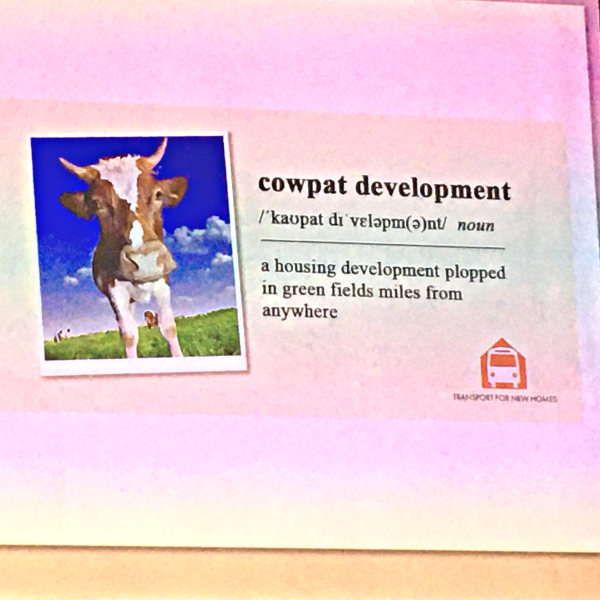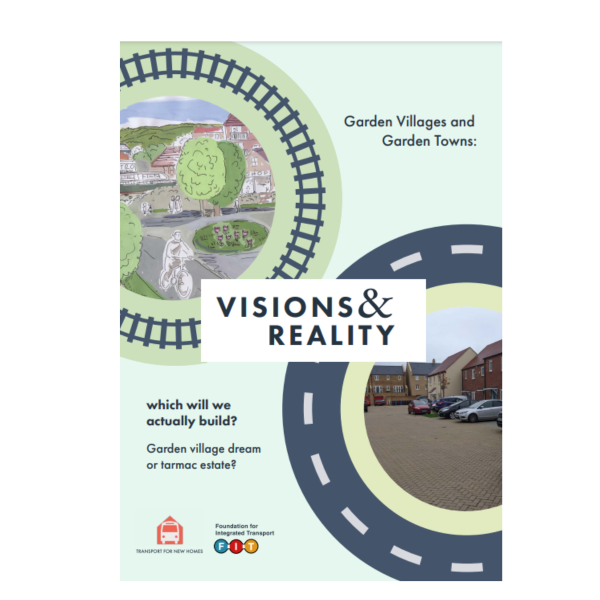Cowpat Developments and the Curse of Car Dependency
What does the word “cowpat” make you think of? No doubt it conjures an image of a less-than-pleasant brown lump in an otherwise green and pleasant field. Well, this is why cowpat developments are so-named: they are dropped in the middle of greenfield land and tend to be completely separated from the local amenities and facilities. Not a good or sustainable place to live in.
Developments Built for Cars Not People
Transport For New Homes (https://www.transportfornewhomes.org.uk/) has been researching how these developments have been building car dependency for thousands at a time when we are supposed to be looking for ways to reduce car use and move towards more environmentally sound ways of living.
Examples they have found from visiting 20 greenfield development sites around the country show that typical developments on greenfield sites (no previous use other than as farmland/ parkland/ open space) are designed around the car in every possible way. This forces the new residents to be solely dependent upon their private motorised vehicles to access shops, services and facilities.
Interestingly, they found that former brownfield sites (areas which were developed previously for industrial or commercial use) tend to be more accessible by other means of transport, including public transport links, walking, cycling and wheeling.
The Reality of Cowpat Homes
The issue with these developments is that they tend to be advertised as “luxury” or “rural”, selling the notion of everyone living in a blissful green paradise; whereas the reality is that the number of cars making journeys to and from this idyll clog up the roads, pump pollution into the atmosphere and exclude those that want to move away from car dependency or those that simply do not drive.
The concern here is not just about the current developments that exist, but about those that will be created in the next 3-5 years as part of the current government's agenda to have more homes built. The planning for these developments is not rigorous enough to prevent these future communities being cut-off splats in the middle of no-where, leaving residents either reliant on cars (and therefore the personal cost of this as well as the environmental impact) or unable to access retail, leisure, education or health services.
Photo credit: Brightwayz at Modeshift conference featuring slide by Transport for New Homes.

So What Can Be Done?
Transport For New Homes has been joined by other voices calling for the planning applications for these types of developments to be more closely scrutinised. David Milner, the Director of Create Streets has joined the call for new homes to be planned around people, not cars and suggests that the algorithms used by planning departments needs to change, as the default is currently to build roads and accommodate motorised vehicles.
The Garden Villages and Garden Towns report by Transport for New Homes highlights the fact that whilst many of these types of developments start off with a vision to be sustainable the reality can be very different with car dependency embedded and cars made the easiest travel option for example by siting some next to motorways. It was good news for us to spot that one of the few developments bucking this trend is local to us - Tresham Village near Corby, North Northants. The report considers this site to be genuinely heading towards being self-sustaining with its strong focus on active travel routes and less easy connection to major road networks.
Photo credit: Transport for New Homes website

We all know at least one of these cowpat sites near to our own town, city or village. Some of you may even live in one. Until local authorities are given the tools, training and money to allow them to be more specific about planning, these developments will keep appearing and the roads around them will become more congested. The good news is, there are alternatives and lessons to be learned from other parts of the world, which we will talk about in another blog, so stay tuned.
Here at Brightwayz social enterprise we love to provide information and tips to help you, your colleagues, friends and family travel in safe, active, sustainable ways for everyday journeys.
Our unique range of products is here to help support your active travel campaigns and 100% of profits from sales is ploughed back to support the work we do. Take a look at our range here and find something to help you inspire others to travel in good ways.